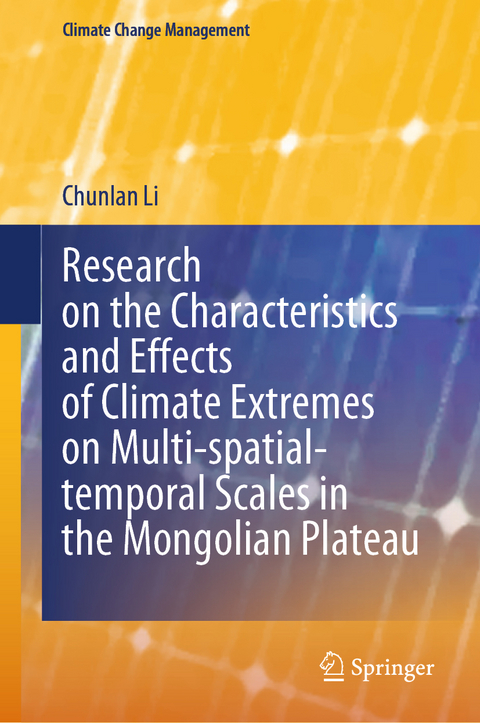
Research on the Characteristics and Effects of Climate Extremes on Multi-spatial-temporal Scales in the Mongolian Plateau
Springer International Publishing (Verlag)
978-3-031-54492-7 (ISBN)
Compared with average climate changes, climate extremes which are considered as low-probability events have greater impacts on natural and social systems due to their suddenness, unpredictability and strong destructiveness. Located in the typical arid-semiarid climate transition zone, the Mongolian Plateau, dominated by herbage animal husbandry, is greatly affected by climate extremes, and its ecosystem is extremely fragile. In the context of global warming, the spatial-temporal variation research about climate extremes and their impacts on vegetation is not only beneficial to the protection of the grassland ecological environment in the Mongolian Plateau, but also of great significance to formulate an effective meteorological disaster risk management.
Based on daily highest temperature, daily minimum temperature and daily precipitation dataset of 111 meteorological stations over Mongolian Plateau from 1961 to 2014. Firstly, sixteen extreme temperature indices and eleven extreme precipitation indices were calculated. Then, multi-spatial-temporal characteristics of climate extremes in the scope of intensity, duration and frequency were analyzed. At the same time, the vegetation variations were analyzed based on GIMMS NDVI3g data. Thirdly, correlation analysis and multiple stepwise regression analysis were used to analyze the relationships between extreme climate indices and NDVI in different spatial scales from the perspective of single factor and multiple factors, respectively. Finally, the future change of climate extremes in duration were explored based on the climate model data. At the same time, the vulnerable areas of grassland and forest were also identified, and adaptive options of different scales were proposed.
Researchers engaged in extreme climate change and managers of government departments are the readership/primary audience for the work.
Dr. Chunlan Li is a Associate Professor in School of Geographic Science in East China Normal University, and a major researcher in the Center for Geopolitical and strategic studies and Institute for Global Innovation and Development in East China Normal University. She is also a researcher in Key Laboratory of Geographic Information Science (Ministry of Education) and Institute for National Safety and Emergency Management in East China Normal University.
Dr. Chunlan Li focuses on Climate change and sustainable development, Cryosphere geopolitics, Geography education and Classroom teaching behavior. She has written, co-written, edited or co-edited more than 40 publications, including books, book chapters and papers in refereed journals.
Chapter 1 Introduction.- Chapter 2 Research Area Overview and Research Methodology.- Chapter 3 Analysis of Extreme Temperature Event Change Characteristics and Influencing Factors.- Chapter 4 Analysis of Extreme Precipitation Event Change Characteristics and Influencing Factors.- Chapter 5 Study on Extreme Climate Event Impacts on Vegetation on the Mongolian Plateau.- Chapter 6 Evaluation and Projection of Extreme Climate Events on the Mongolian Plateau.- Chapter 7 Conclusion and Outlook.
| Erscheinungsdatum | 30.03.2024 |
|---|---|
| Reihe/Serie | Climate Change Management |
| Zusatzinfo | XIV, 163 p. 54 illus., 26 illus. in color. |
| Verlagsort | Cham |
| Sprache | englisch |
| Maße | 155 x 235 mm |
| Themenwelt | Naturwissenschaften ► Biologie ► Ökologie / Naturschutz |
| Naturwissenschaften ► Geowissenschaften ► Meteorologie / Klimatologie | |
| Schlagworte | Climate extremes • Impact Factor • Mongolian Plateau • NDVI(Normalized Difference Vegetation Index) • Variation characters of temporal-spatial |
| ISBN-10 | 3-031-54492-7 / 3031544927 |
| ISBN-13 | 978-3-031-54492-7 / 9783031544927 |
| Zustand | Neuware |
| Haben Sie eine Frage zum Produkt? |
aus dem Bereich


